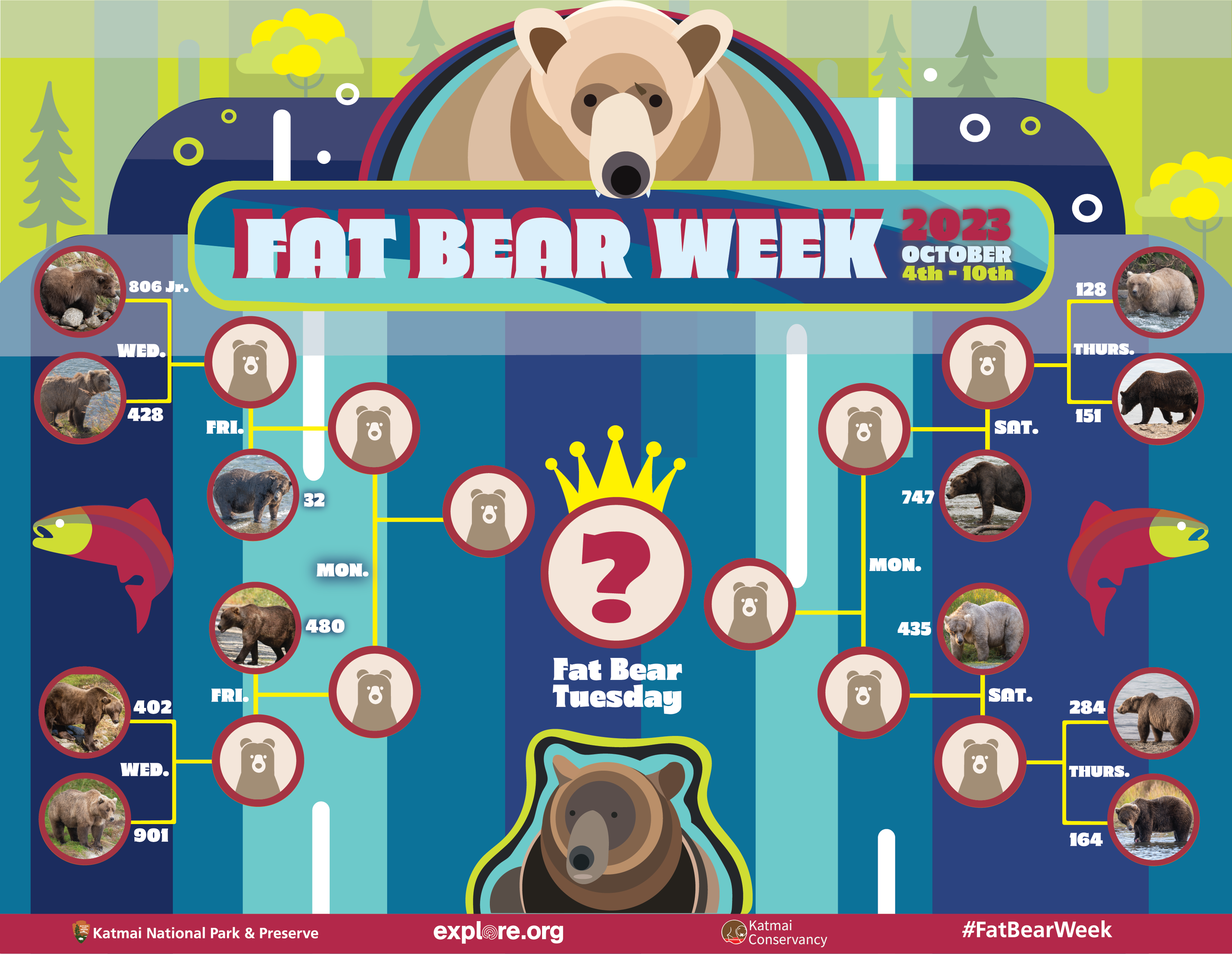
What is Fat Bear Week?Fat Bear Week is a celebration of success and survival. It is a way to celebrate the resilience, adaptability and strength of Katmai’s brown bears. Bears are matched against each other in a tournament style competition and online visitors can vote on which bear is ultimately crowned the Fat Bear Week 2023 Champion. Over the course of the week, virtual visitors learn more about the lives and histories of individual bears while also gaining a greater understanding of Katmai’s ecosystem through a series of live events hosted on explore.org. Join us this Fat Bear Week October 4-10 and vote daily from 8am - 5pm AKDT at fatbearweek.org! Meet the Bears of Fat Bear Week 202332 Chunk 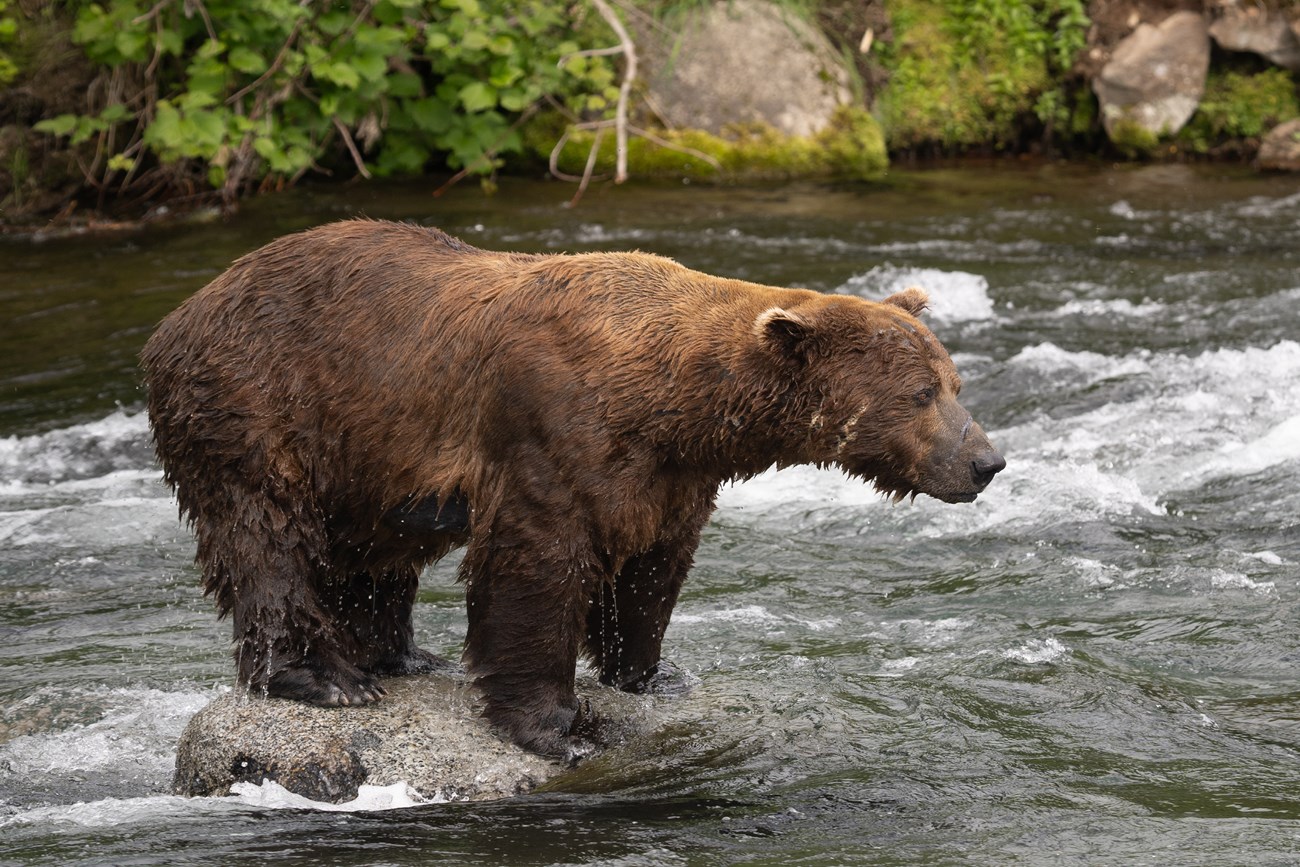
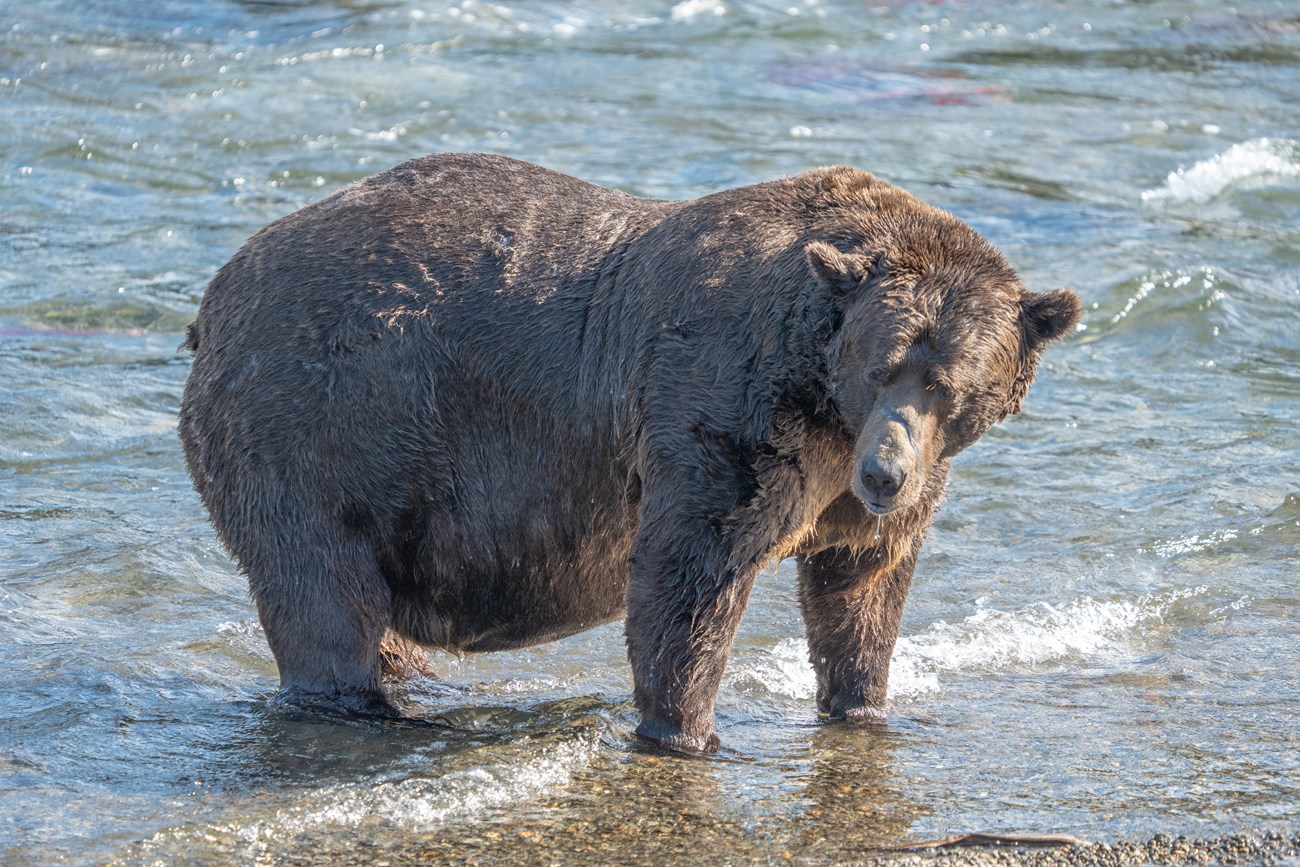
Left image
Right image
Identification32 Chunk is a large adult male with narrowly-set eyes, a prominent brow ridge, and a distinctive scar across his muzzle. Even at his leanest, Chunk carries substantial fat reserves, especially on his hind quarters. In early summer he tends to shed much of the fur around his shoulders and neck. This gives him a two-toned appearance and exposes numerous scars and wounds. By late summer, his newly grown fur is dark brown.Biography32 Chunk was first identified in 2007 as an independent, chunky-looking 2.5-year-old bear. He has been a large adult for several years. Yet, in past years his behavior was enigmatic. He would sometimes play with other bears or wait patiently to scavenge leftover salmon. He was also often unwilling or unable to successfully challenge some of the other big males at Brooks River. In summer 2023, however, Chunk used his size and confidence to his advantage. Even bear 747 deferred fishing spots and salmon to him. This gave Chunk greater access to his most preferred fishing spots. In 2023 he ranked among the river’s largest and most dominant males.Due to his size and strength, Chunk has gained the confidence and ability to take advantage of opportunities not available to most other bears. But it is only by observing his full range of behaviors that we can get a true sense of his individuality. His low hanging belly and ample hindquarters bear the fruit of his summer success. 128 Grazer 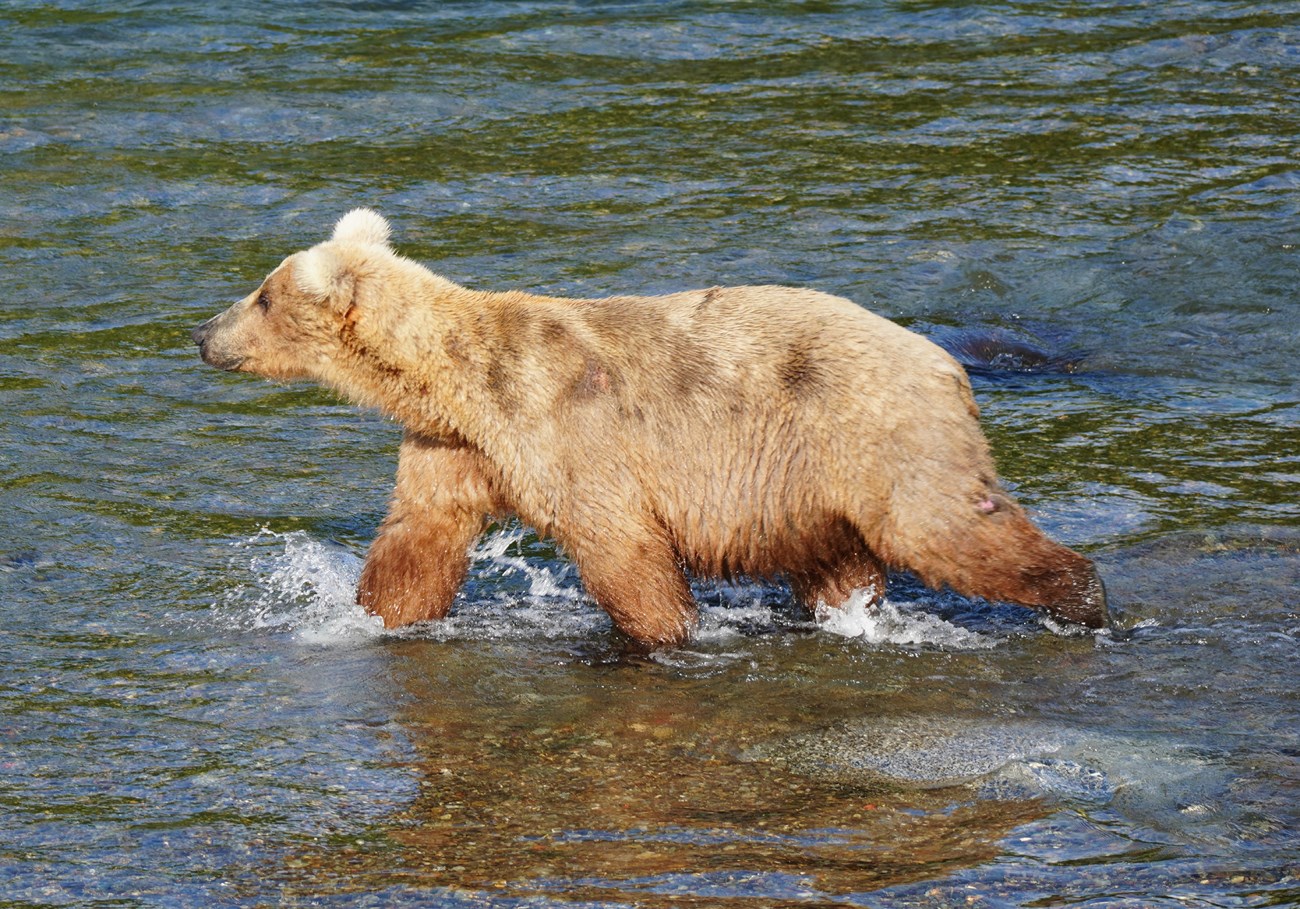
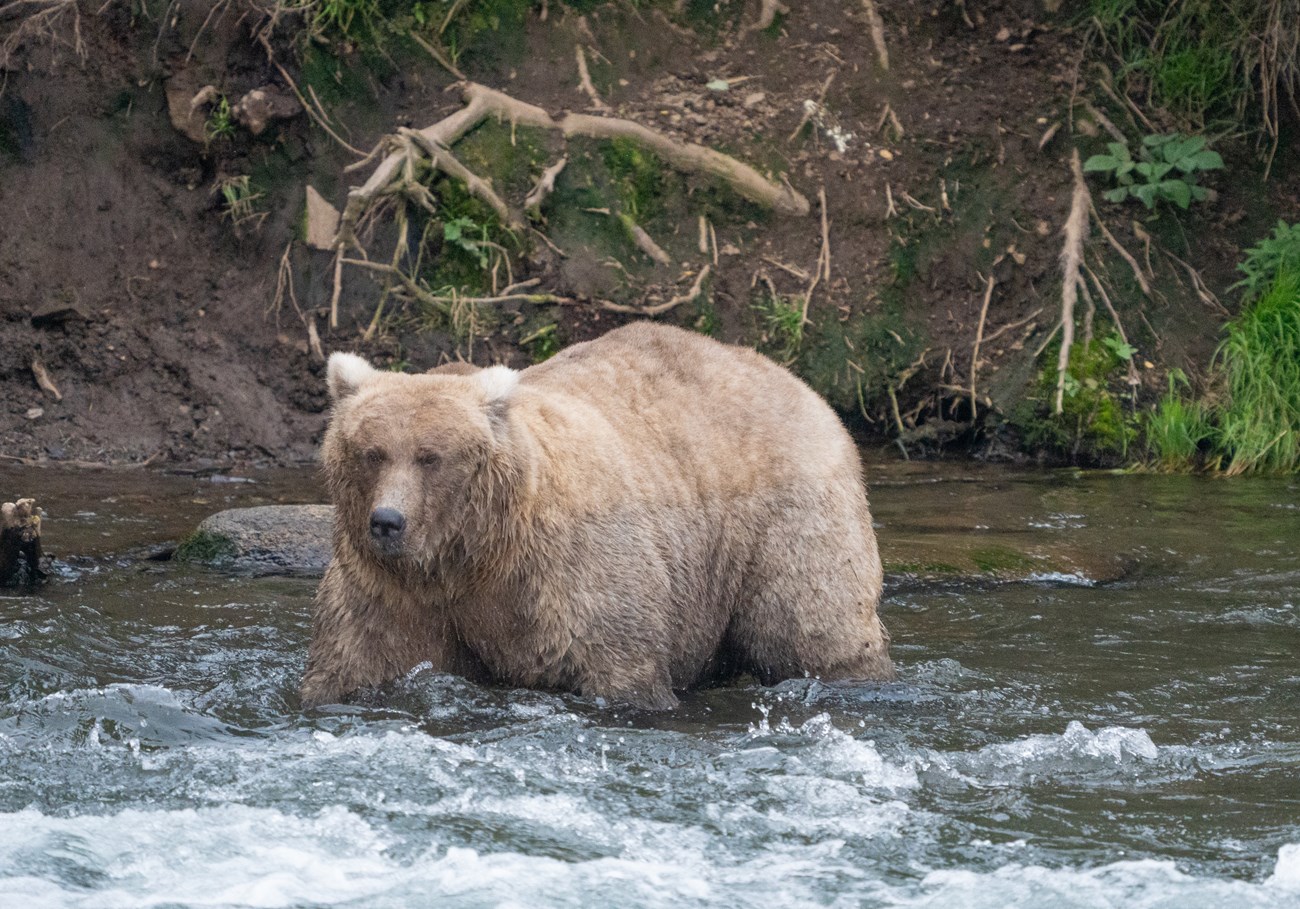
Left image
Right image
IdentificationGrazer is a large adult female with a long straight muzzle and conspicuously blond ears. During late summer and fall, she has grizzled, light brown fur and is often one of the fattest bears to utilize Brooks River.BiographyGrazer was introduced to Brooks River as a young cub in 2005. Since then, she’s become one of the best anglers at Brooks River. She can fish successfully in many locations including the lip, far pool, and plunge pools of Brooks Falls. She can chase down fleeing salmon in many parts of the river or patiently scavenge dead and dying salmon after they spawn. Grazer will also fish overnight at Brooks Falls.Grazer is a particularly defensive mother bear who has successfully raised two litters of cubs. She often preemptively confronts and attacks much larger bears—even large and dominant adult males—in order to ensure her cubs are safe. Her behavior produced benefits beyond the protection of her cubs. In summer 2023, many other bears remembered her reputation and Grazer maintained a high level of dominance even though she was single. For example, a large adult male, 151 Walker, regularly avoided her approach. Grazer’s combination of skill and toughness makes her one of Brooks River’s most formidable, successful, and adaptable bears. 151 Walker 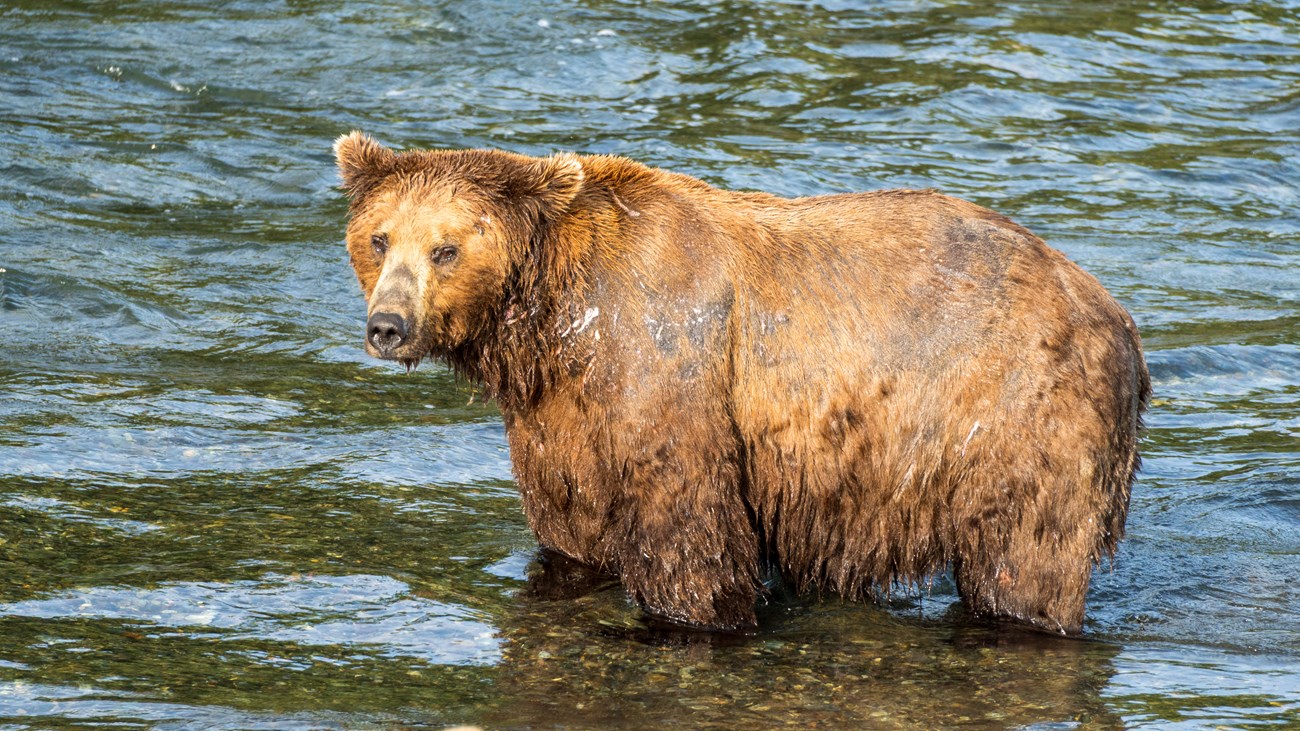
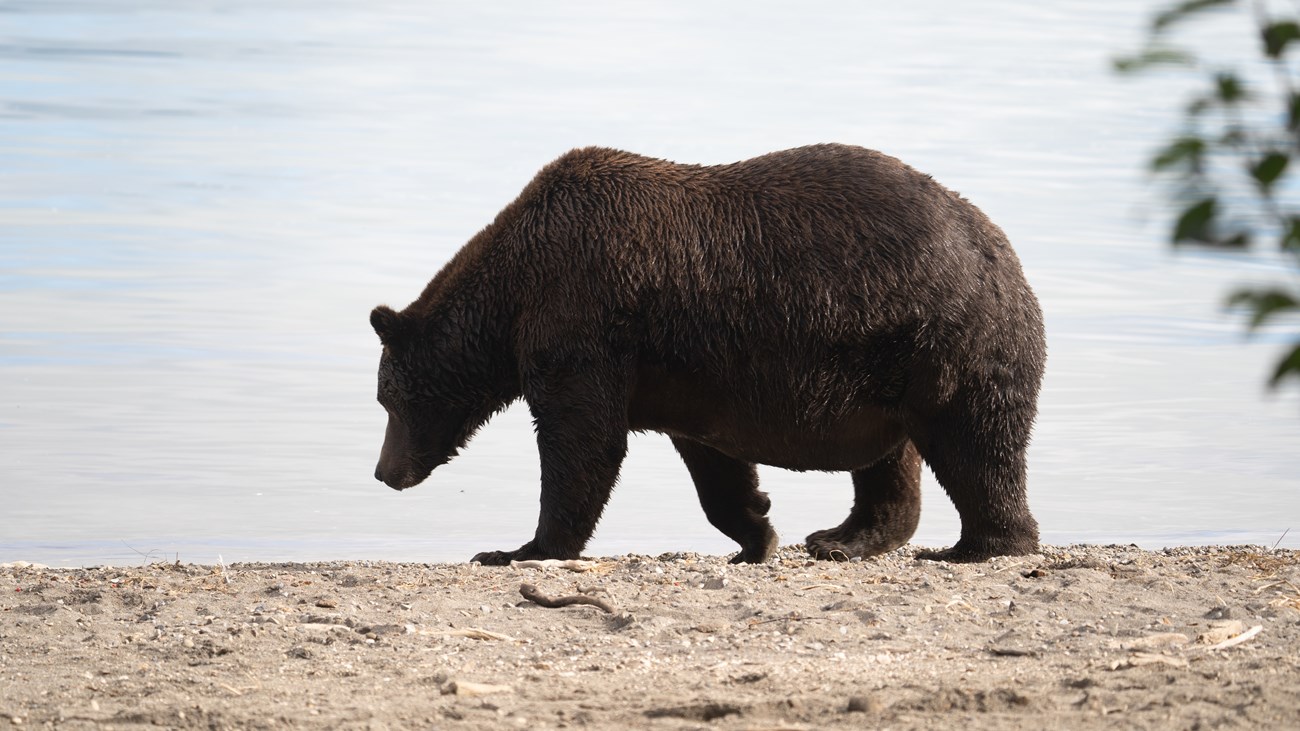
Left image
Right image
IdentificationWalker is a large adult male. He has a long, tapering muzzle and widely spaced, upright ears. In early summer he often has dark eye rings. By late summer Walker’s fur is dark brown and he has a light bulb or pear-shaped body.BiographyWalker was first identified as an independent 2.5-year-old in 2009. He’s a frequent user of Brooks Falls and the nearby vicinity where he prefers to fish in the far pool, on the lip, and in the riffles. He often has easy access to productive fishing spots due to his size and disposition.Walker remained a tolerant and playful bear during his young adult years. He ranks high currently in the hierarchy of bears at Brooks River and shows much less tolerance for other bears compared to his younger self. He establishes and maintains his dominance at Brooks Falls by displacing other bears from preferred fishing spots. However, his position in the hierarchy was frequently challenged this year by other bears such as 856, Brooks River most dominant male, and 128 Grazer. Walker’s experiences demonstrate that behavioral change and new challenges are facts of life for bears. 164 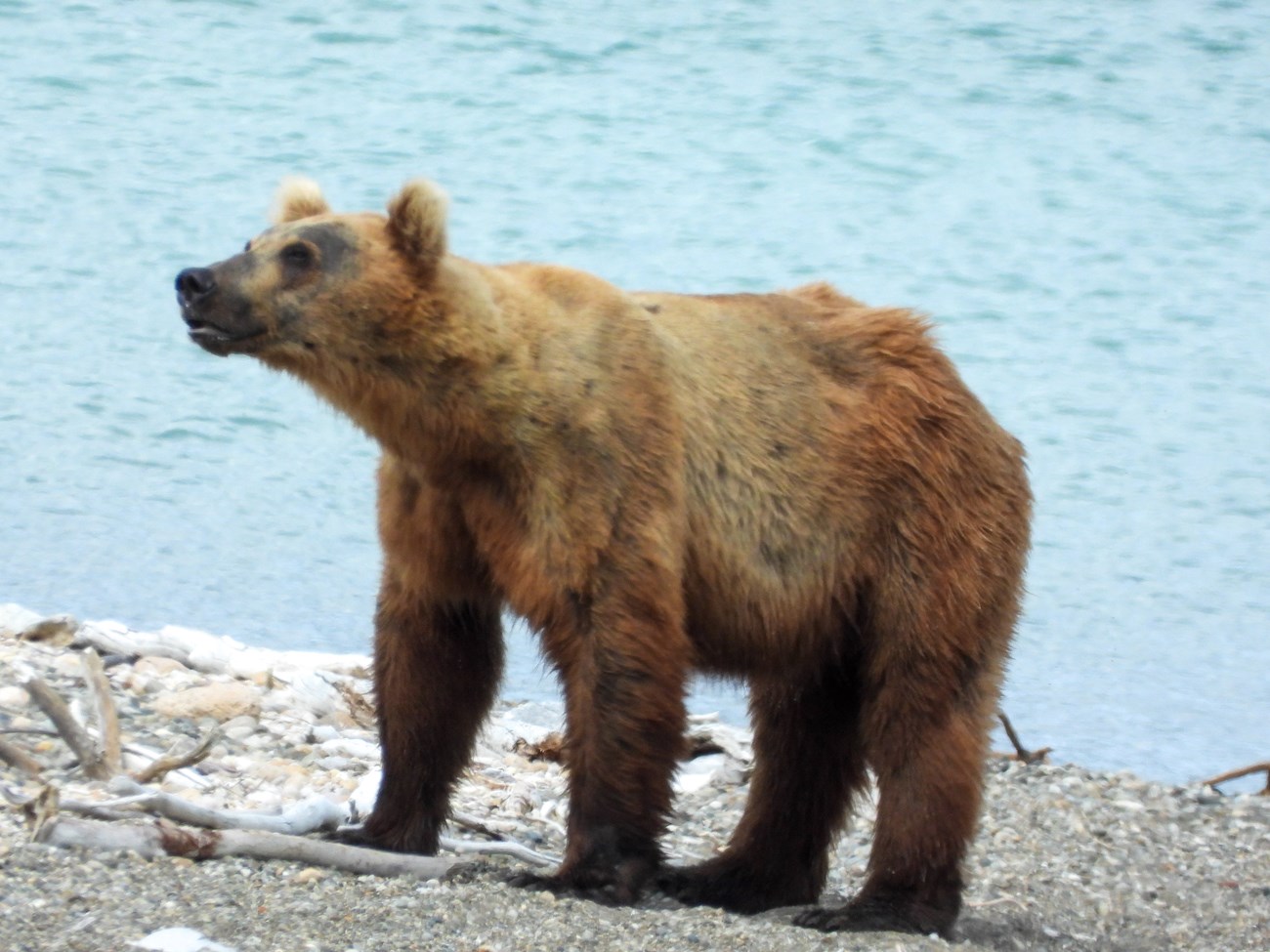
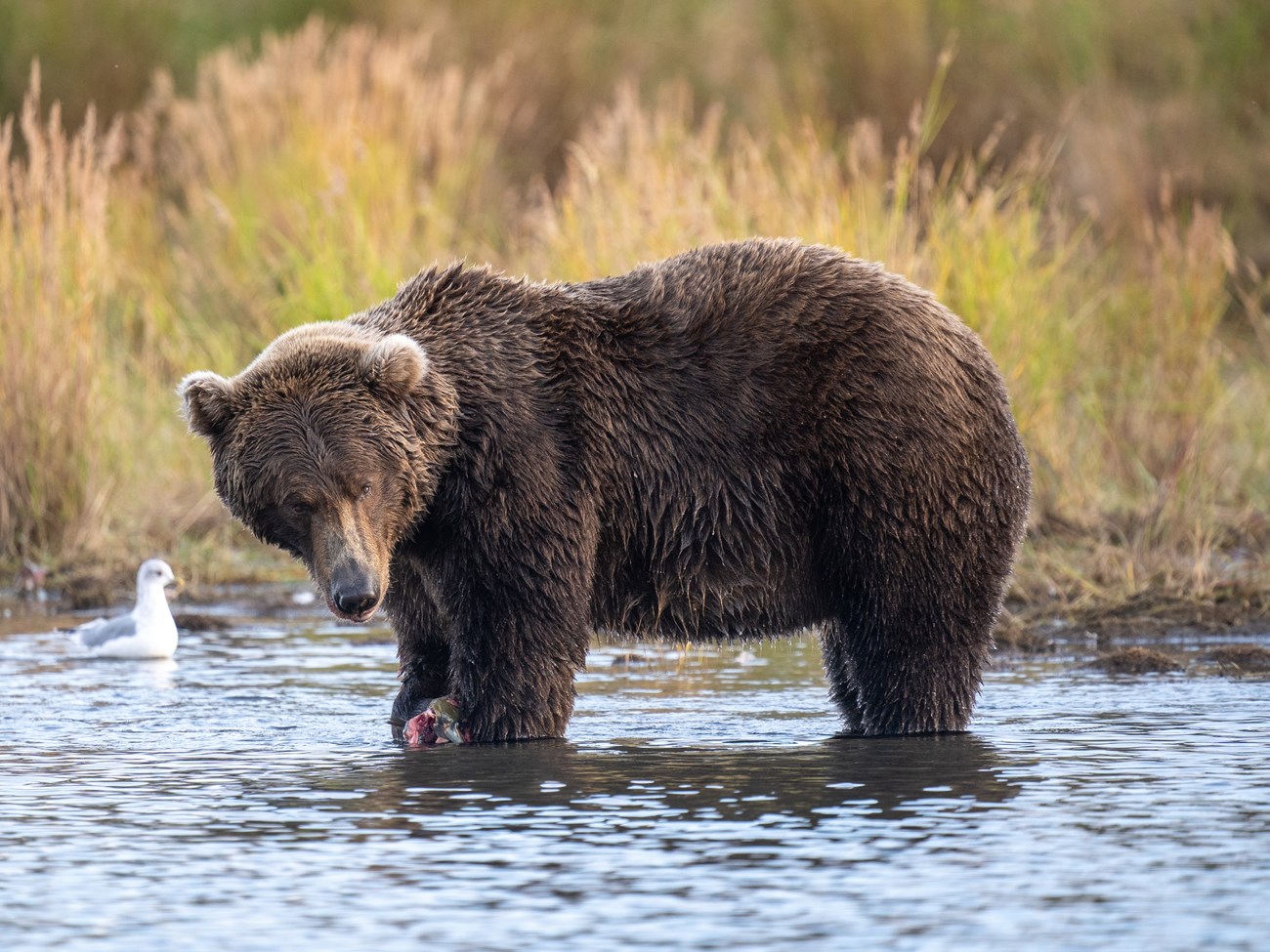
Left image
Right image
IdentificationBear 164 is a medium-sized adult male. In early summer, he has light brown body fur with darker brown fur on his lower legs. His fur becomes dark brown in late summer. Many observers identify 164 by an apparent indentation at the base of his upper muzzle.BiographyInstead of competing for established fishing spots like most bears at Brooks Falls, 164 invented his own. He stands at the very base of Brooks Falls at the edge of the deepest plunge pool. At this location, he can catch salmon welling up from the pool below, jumping through the air, or falling from above. This is a spot that no other bear—currently or in the recent past—has tried to fish consistently.Fishing at Brooks Falls isn’t easy for young bears. It can be difficult to develop angling skills when larger bears occupy the most productive and easiest to access fishing spots. As he grows (and appears to have grown a lot in summer 2023) he’ll become better positioned to compete for more traditional and productive fishing spots at Brooks Falls. Through innovation, bear 164 carved himself a unique niche at Brooks Falls, but how might his behavior change as he continues to mature? 284 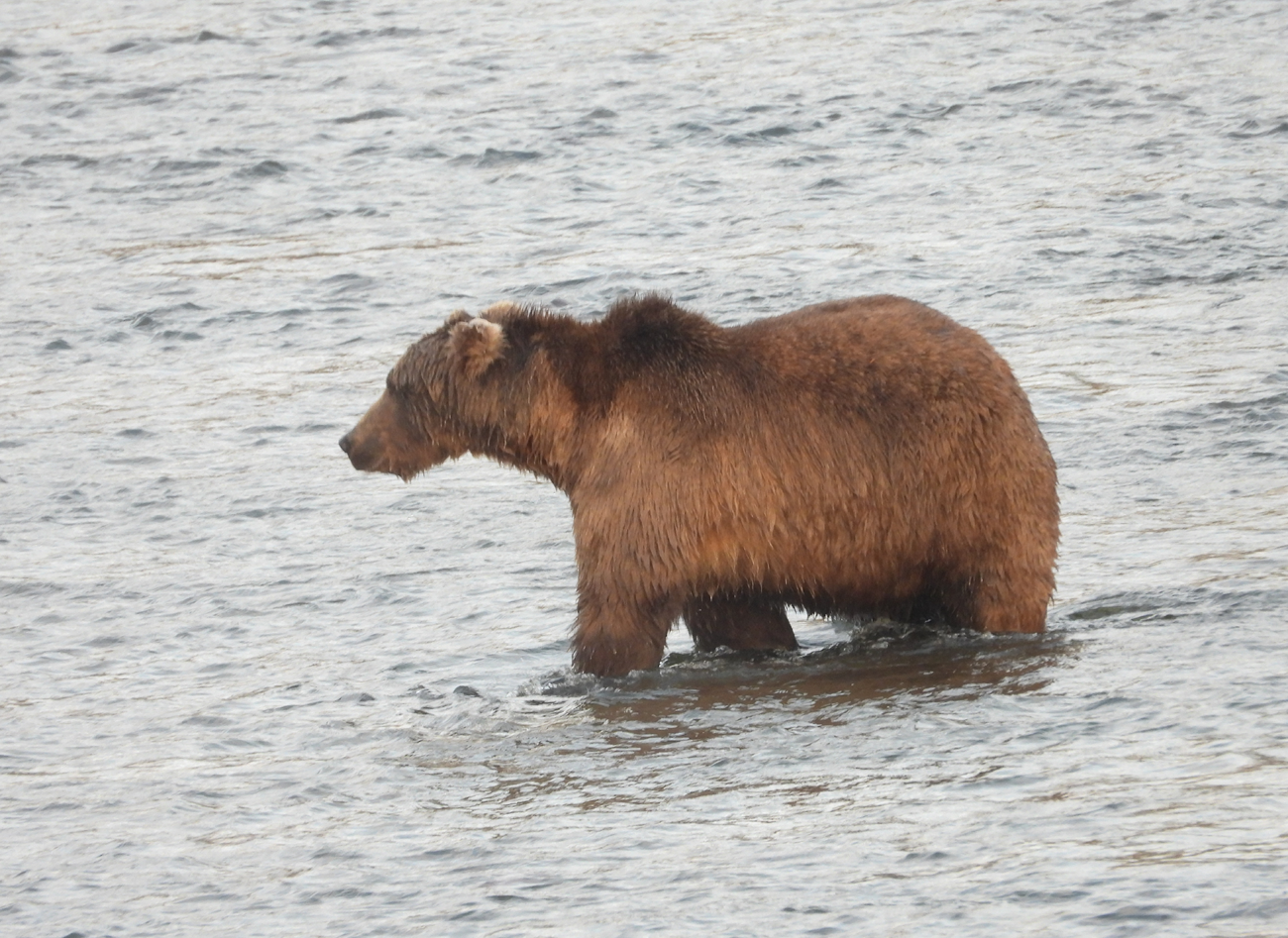
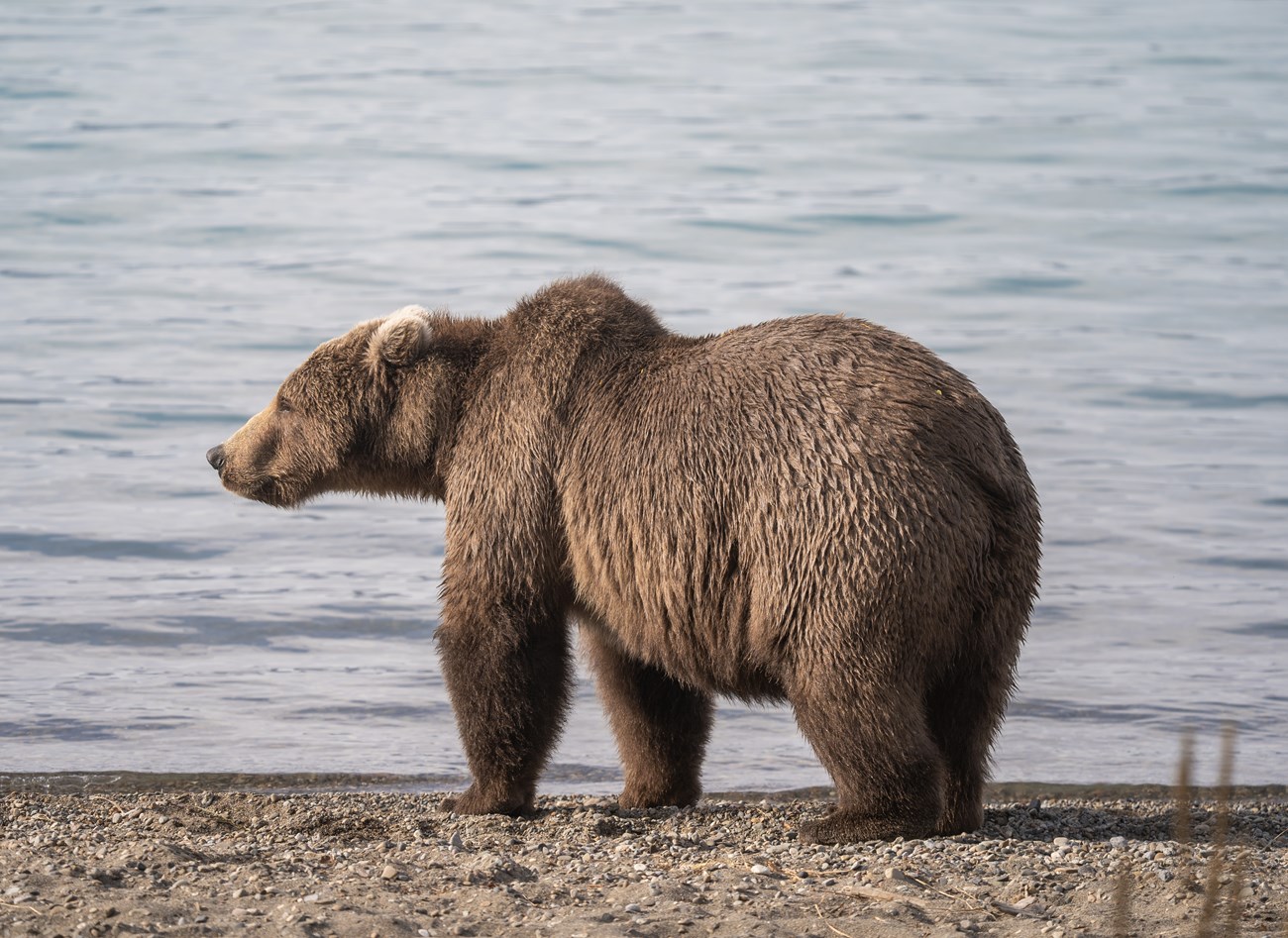
Left image
Right image
IdentificationBear 284 is a medium sized adult female with perky ears, a long neck, and prominent shoulder hump. She has uniformly brown fur in July. Her fur in late summer and fall remains brown but is often grizzled.BiographyBear 284 established her presence quickly at Brooks River after she separated from her mother in 2011. She’s used the river every year since. She’ll fish the lower river and occasionally in the vicinity of the falls. Bear 284 has had two known litters, and some of her former cubs have made Brooks River part of their home range. Notably, 901, another Fat Bear Week contender and product of 284’s 2016 litter, returned to Brooks River with three spring cubs in summer 2023.Bear 284’s family line has long used Brooks River. In addition to some of 284’s offspring, 284’s mother, 708 Amelia, was raised along Brooks River by 468 Reggie. Bear 284’s legacy, like that of her mother and her grandmother, was cemented as she protected her cubs and showed them the skills necessary to survive. She’s part of a legacy that spans generations. 402 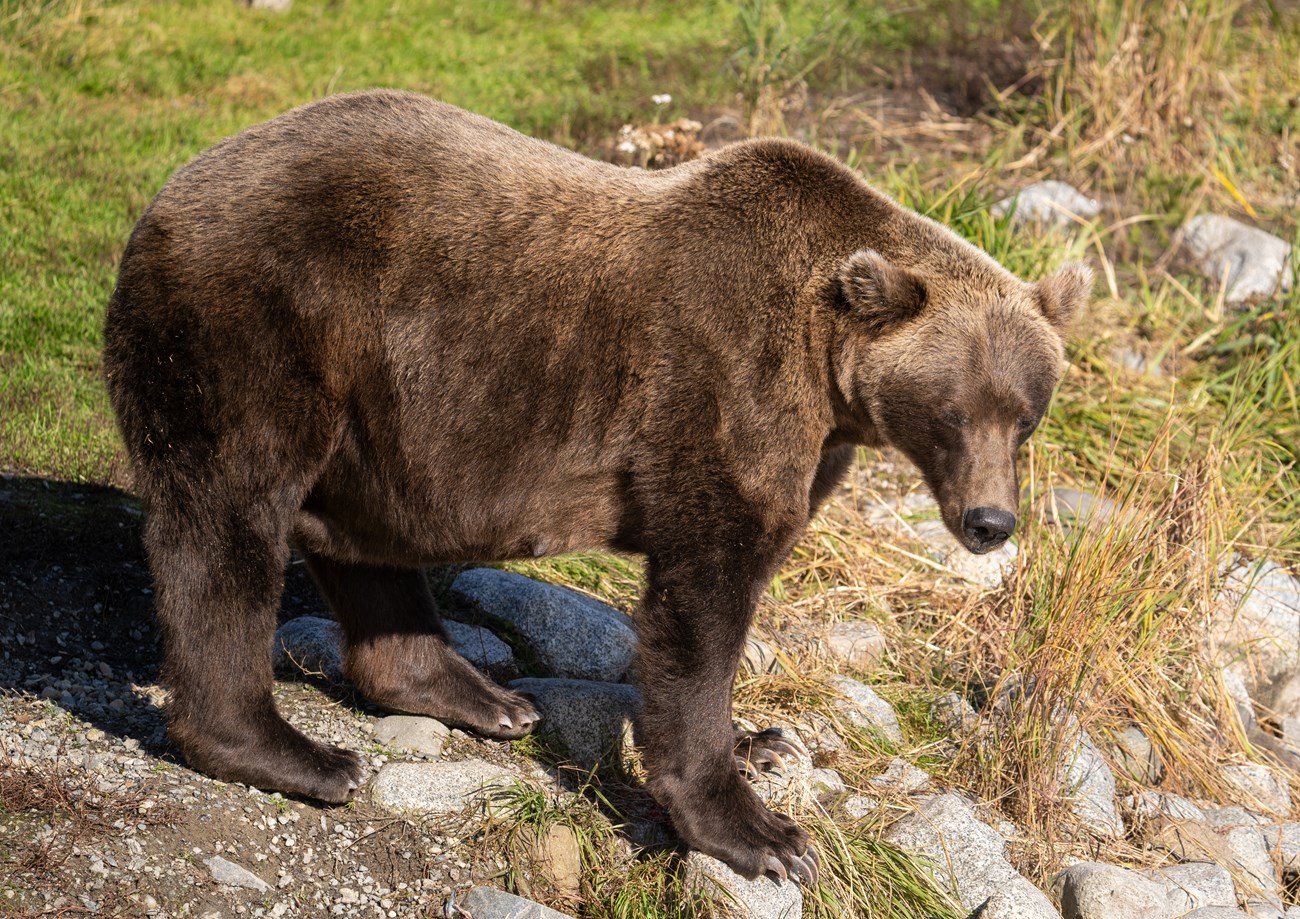
Left image
Right image
IdentificationBear 402 is a large adult female. She has medium brown fur, tan-colored claws, and crescent or apostrophe-shaped ears when viewed from front or back. During years when she is not caring for cubs, she is also quite fat in late summer and fall.BiographyFew bears can rival 402’s maternal experience. She is the mother of at least eight litters, more than any other bear currently at Brooks River. This includes two litters of four cubs apiece. While 402 has weaned many cubs, some of which still visit Brooks River, she’s also experienced the loss of entire litters. When a mother bear loses her litter in spring or early summer, it can trigger her to become receptive to mating once again. This explains why 402 bore litters in back-to-back years such as 2007 and 2008.Although female bears need ample fat reserves to support gestation, birth, and milk production in the den, fat is only part of the equation for maternal success. Cubs are ravenous and mothers must provision them with milk and other foods during their active seasons. Bear 402 is a skilled angler especially on the lip of Brooks Falls and often brings her cubs there. She is also an efficient scavenger of dead and dying salmon in the lower Brooks River. Even experienced mother bears experience loss, though. One of the cubs from her most recent litter disappeared in 2022. This summer, she continues to care for her single yearling. Her life illustrates the triumphs and difficulties of a long-lived mother bear. 428 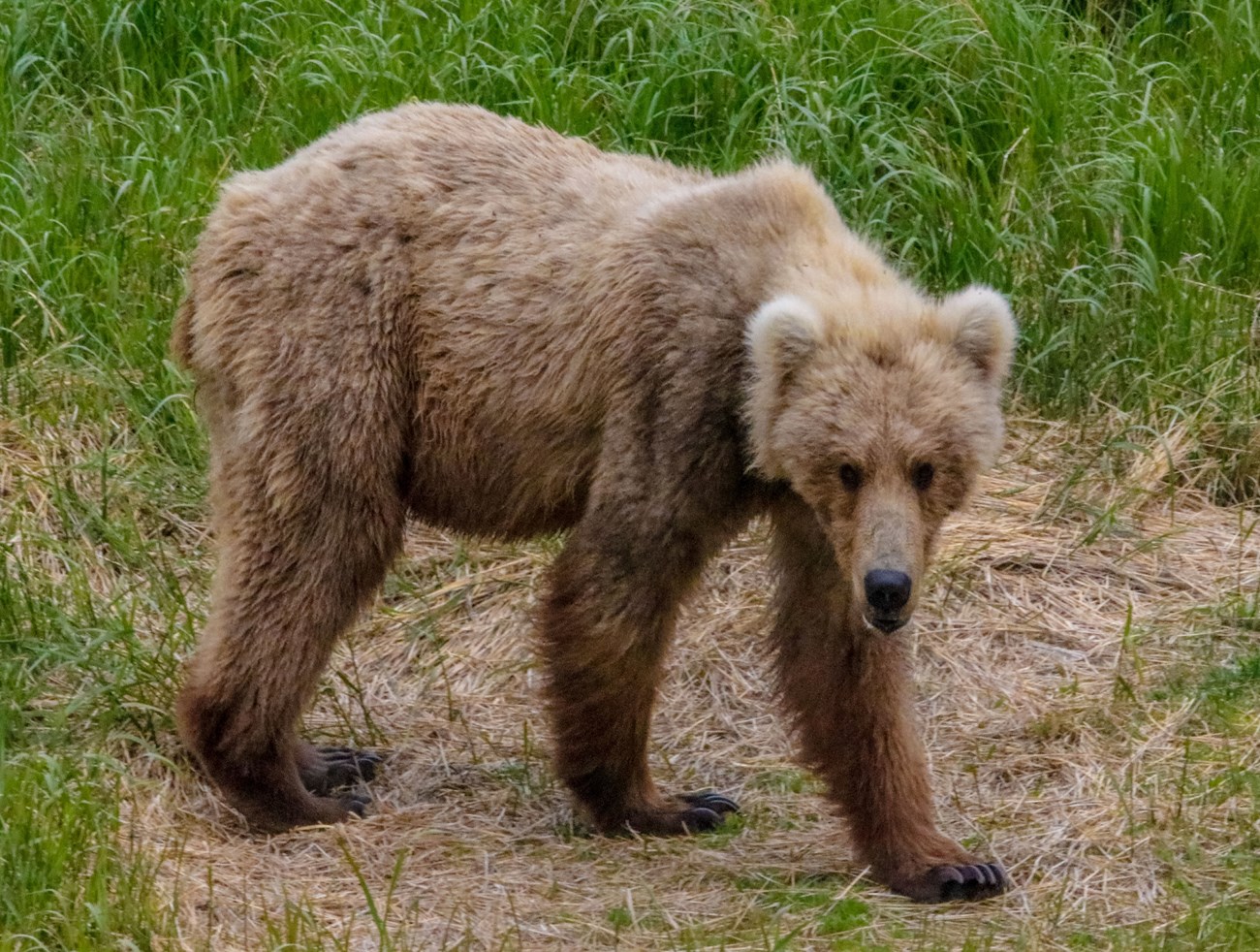
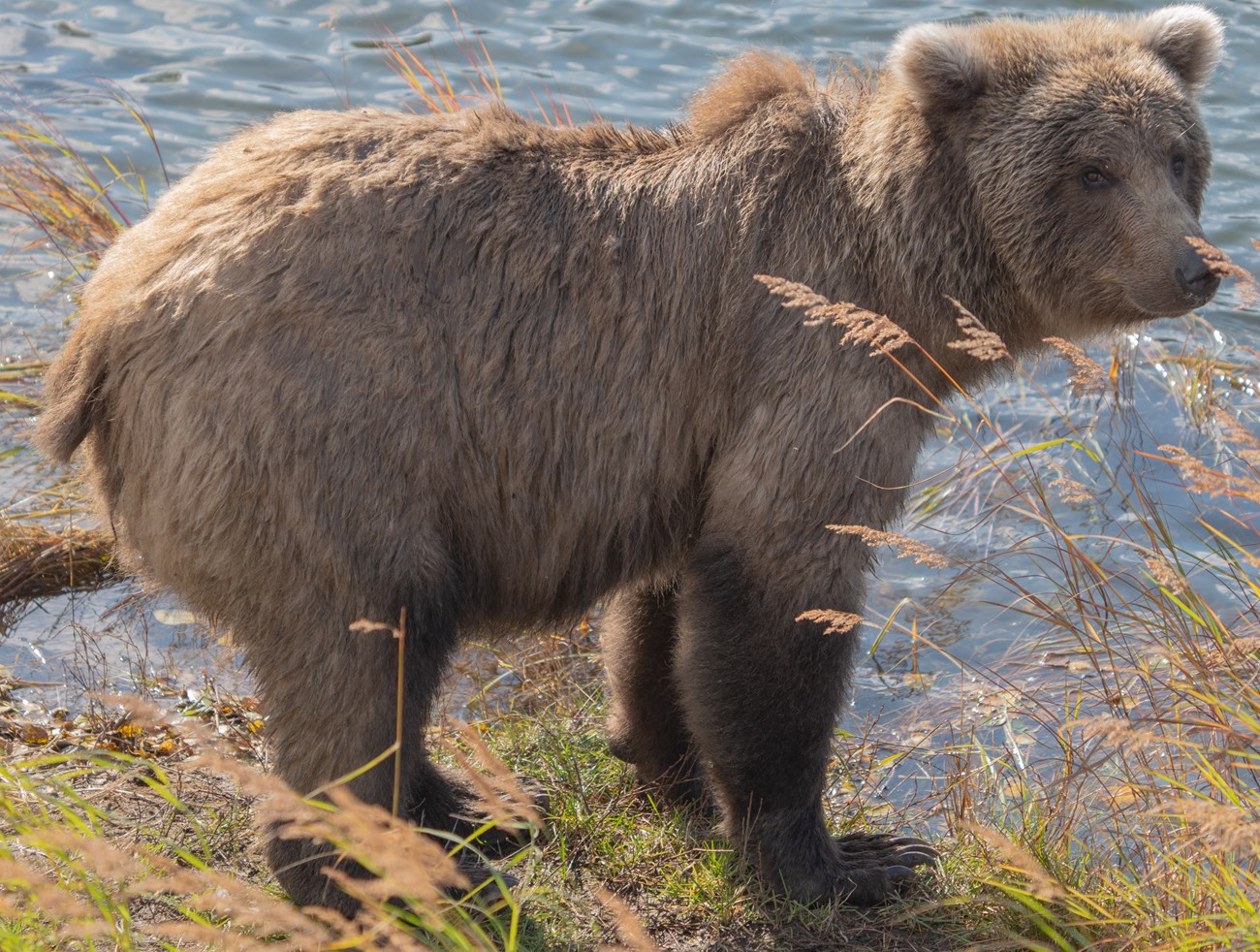
Left image
Right image
IdentificationThis is a pudgy 3.5-year-old subadult bear. Bear 428 has blond ears and grizzled, light brown fur. She is difficult to differentiate from her same-aged sister, 429.BiographyThis is a pudgy 3.5-year-old subadult bear. Bear 428 has blond ears and grizzled, light brown fur. She Bear 428 is the offspring of 128 Grazer, a perennial presence at Brooks River. As a dominant mother bear, Grazer provided her cubs with consistent access to productive fishing spots at Brooks Falls. As a yearling and 2.5-year-old cub, 428 followed her mother’s lead. She took to the lip of the falls to practice fishing in a location that many bears compete for and that younger bears are often displaced from by larger bears.As an independent bear in 2023, she navigated the river without mother’s guidance for the first time. Easy access to the lip of the falls and other productive fishing spots were no longer something she could count on. She navigated these new challenges by utilizing opportunity as it came even if opportunity came inconsistently. 435 Holly 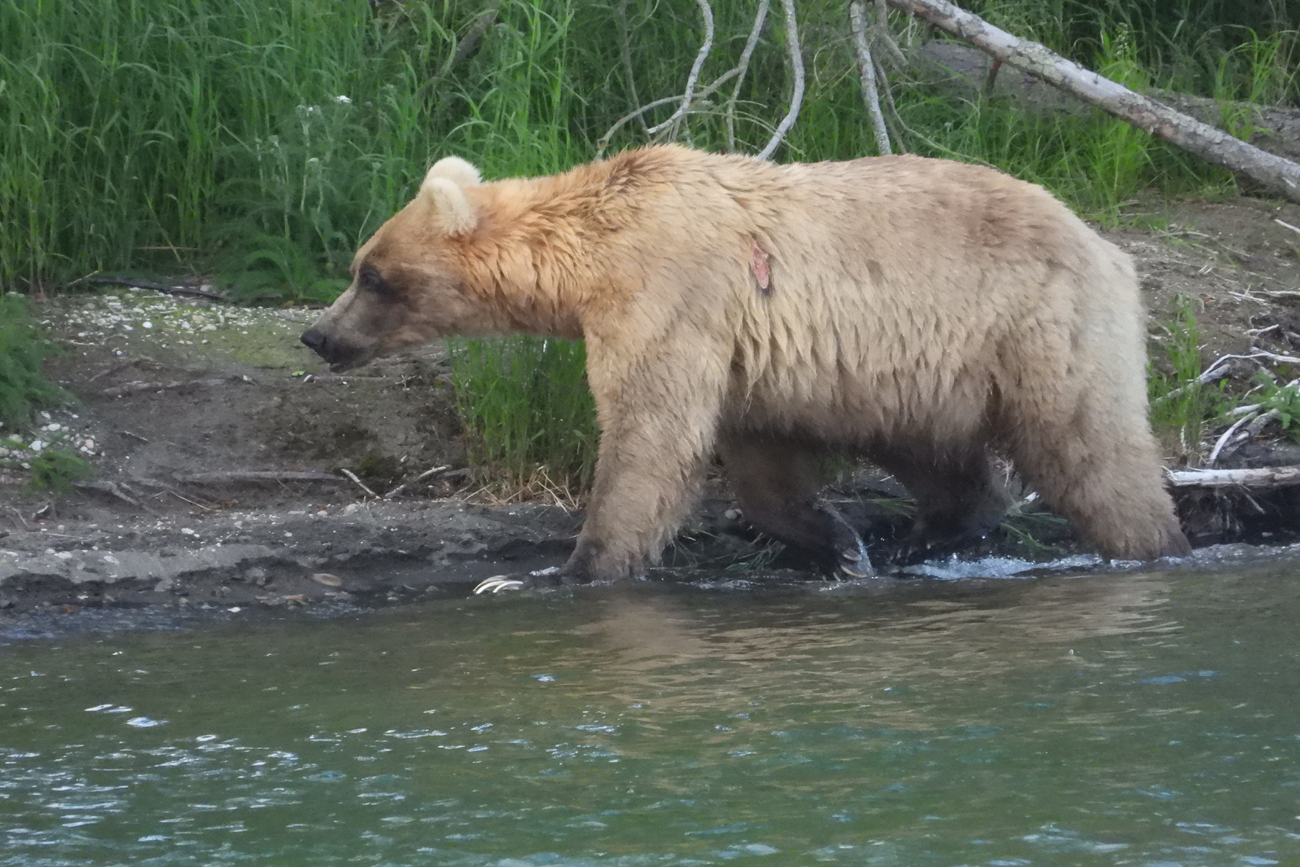
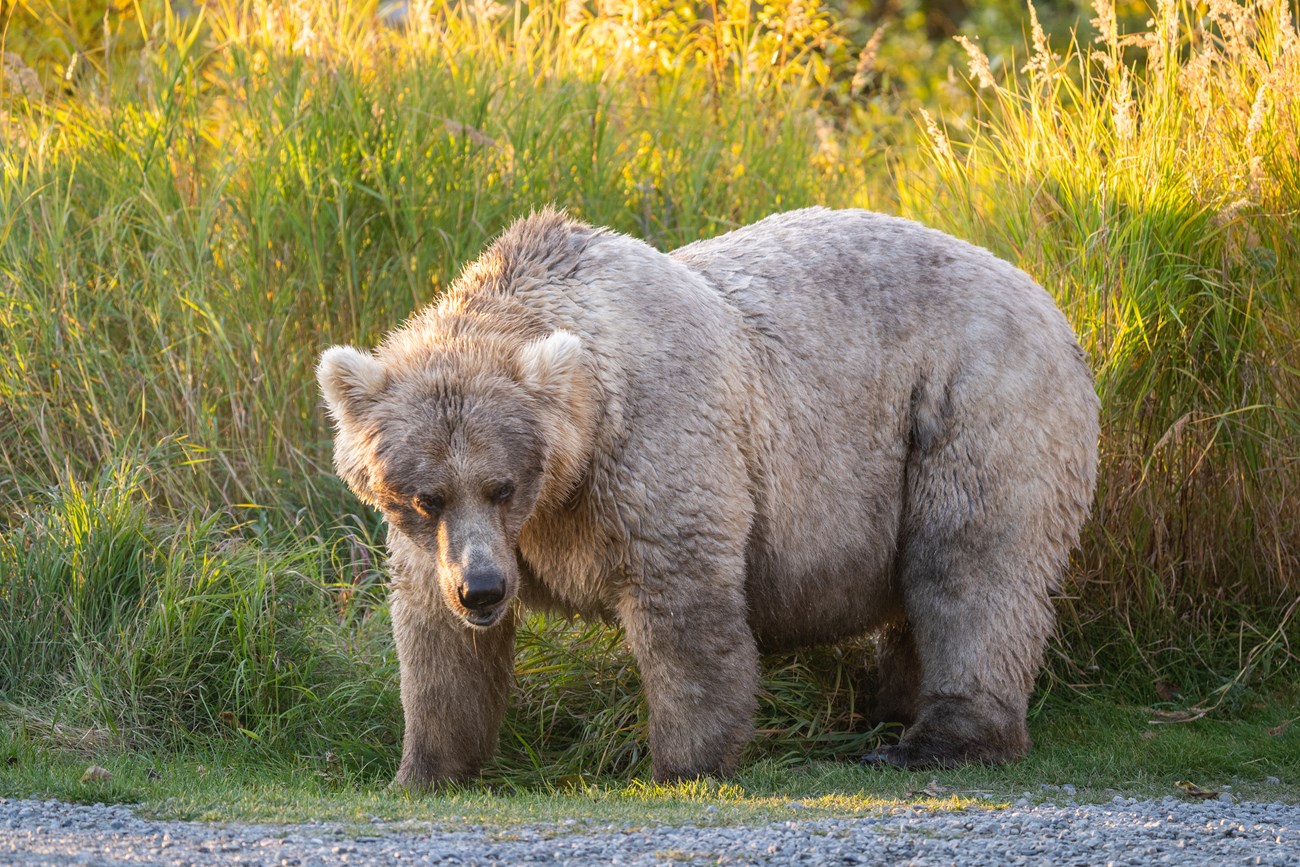
Left image
Right image
Identification435 Holly is a large adult female with blond ears and pale, tan-colored claws. By early autumn, she is usually very fat with grizzled blond fur. Her appearance somewhat resembles the shape and color of a lightly toasted marshmallow.Biography435 Holly’s life is one of hardship, surprises, and success. She raised an injured yearling cub in 2007. That yearling bear, now known as 89 Backpack, continues to use Brooks River. In 2014 Holly adopted a lone yearling cub into her family. Holly cared for and raised this bear alongside her biological cub, weaning them both in the spring of 2016. Each of those bears are now successful adults—503 and 719. Holly’s spring cub in 2020—now identified as bear 335—suffered from porcupine quills in a front paw, but when Holly returned in 2021 her cub appeared to be fully healed.Holly returned to Brooks River as a single bear in 2023. A bachelorette’s life has afforded her the opportunity to concentrate on her own needs, but like other single females she’ll need ample body fat to survive winter hibernation and potentially give birth to a new litter of cubs in the den. Holly has shown that experience and an ability to adapt lead to longevity and success for brown bears. She was the 2019 Fat Bear Week champion. 480 Otis 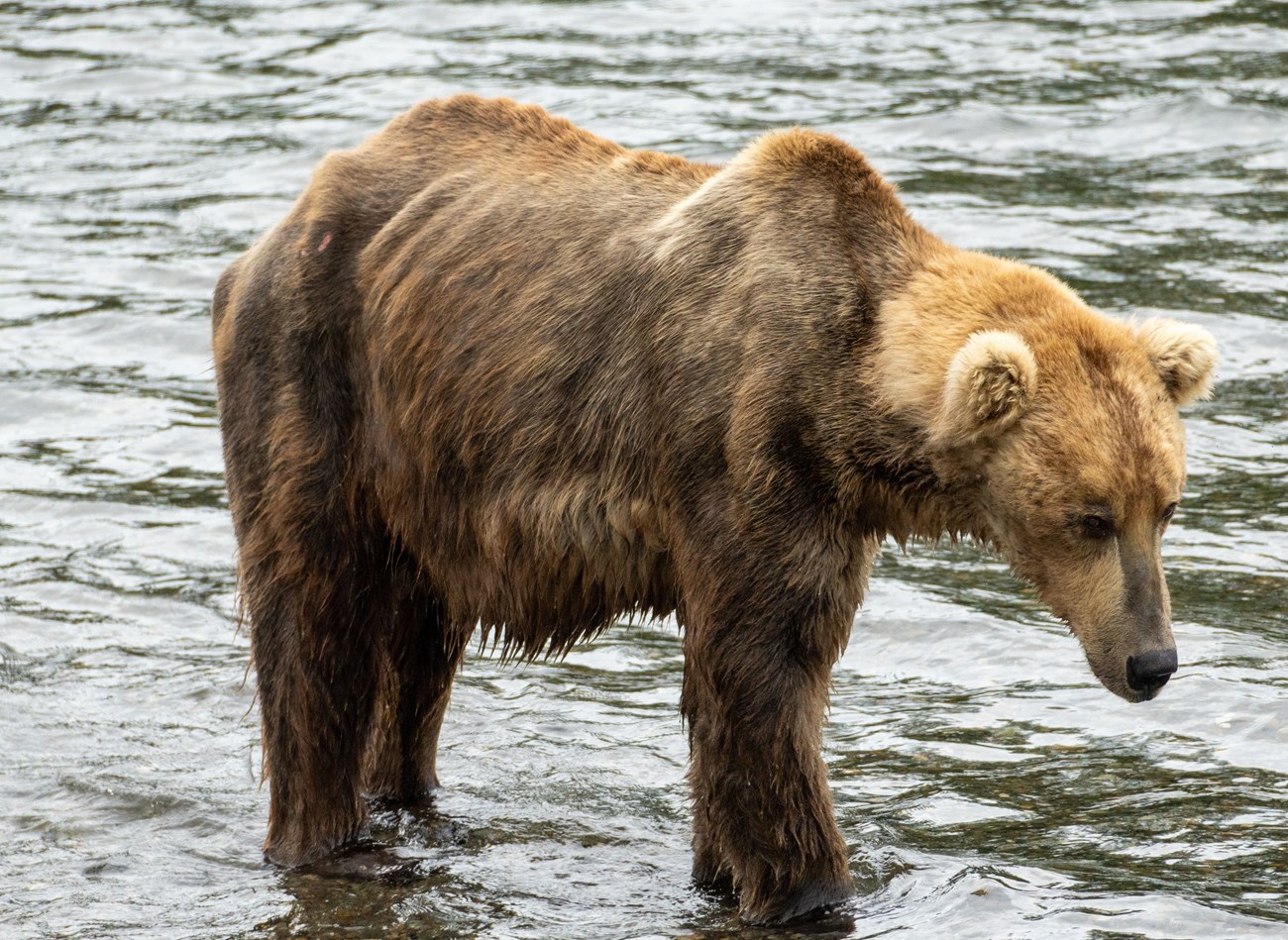
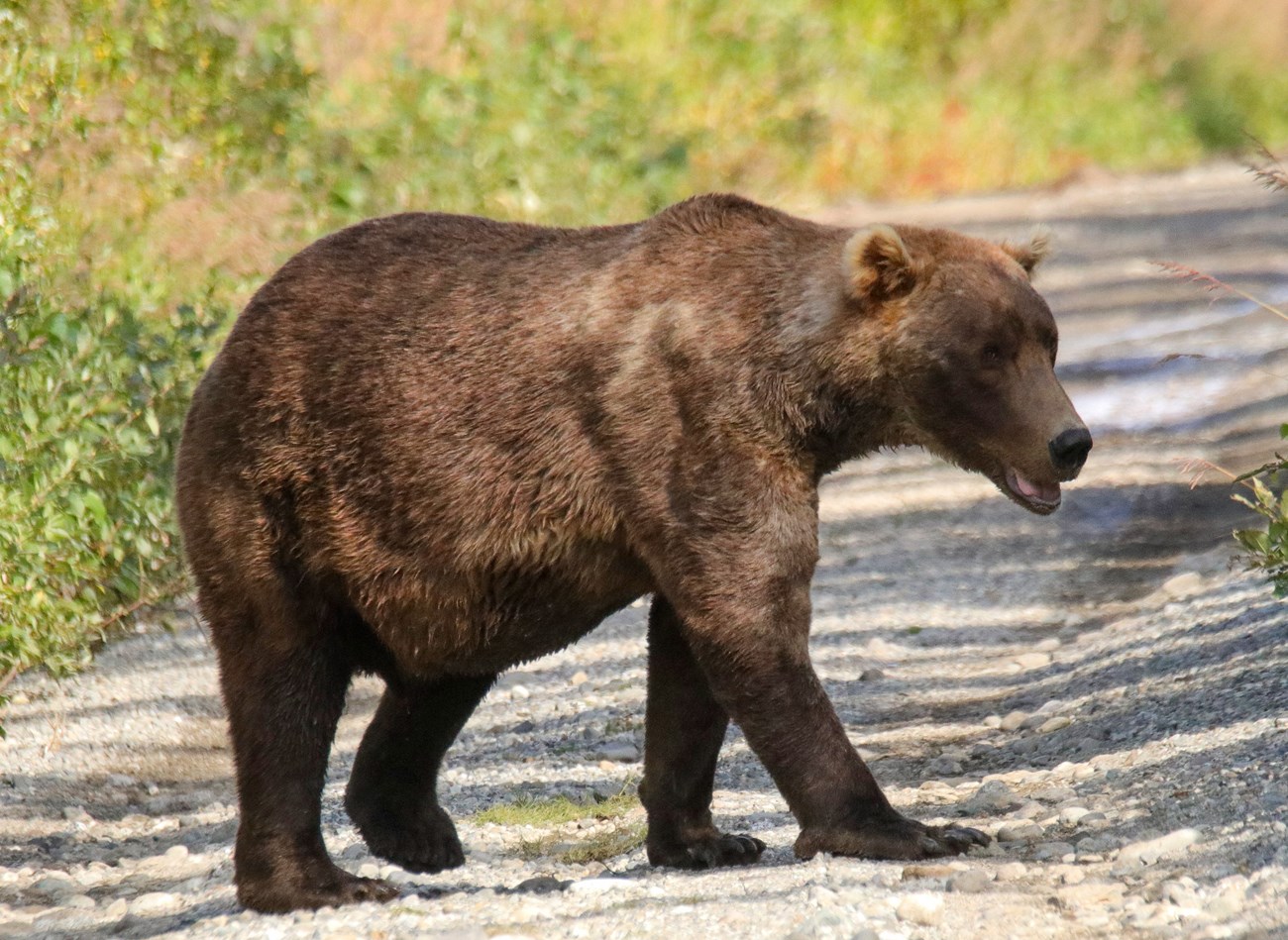
Left image
Right image
IdentificationOtis is a medium-large adult male with a blocky muzzle and a floppy right ear. He has light brown fur in early summer. By autumn, his coat becomes grizzled brown and he sports a patch of blonder fur on his left shoulder.BiographyOtis was four to six years old when he was first identified in 2001, and he’s now one of the older male bears at Brooks River. As bears age, they experience a variety of challenges and Otis is no exception. He faces strong competition from younger adult males for preferred fishing spots. Like many older bears, Otis must also persevere through the poor condition of his teeth. He is missing two canine teeth and many of his other teeth are greatly worn.Otis arrived at Brooks River in late July this summer. Although his whereabouts prior to this are unknown, Otis did not look like he had eaten much of anything before his arrival. He was emaciated with hip and rib bones visible under his skin. Otis would’ve been excused if he decided to chase salmon through the river, but instead he stuck to what he knows works best—patience and persistence. Amazingly, and despite his hunger, Otis sat or stood at the falls and waited for salmon to come to him just like he always has. The effort worked. Otis carried substantial body mass by the end of summer. Otis uses his knowledge, skill, and patience to find success. He has won more Fat Bear titles than anyone. He was the inaugural Fat Bear Tuesday champion in 2014 and Fat Bear Week champion in 2016, 2017, and 2021. 747 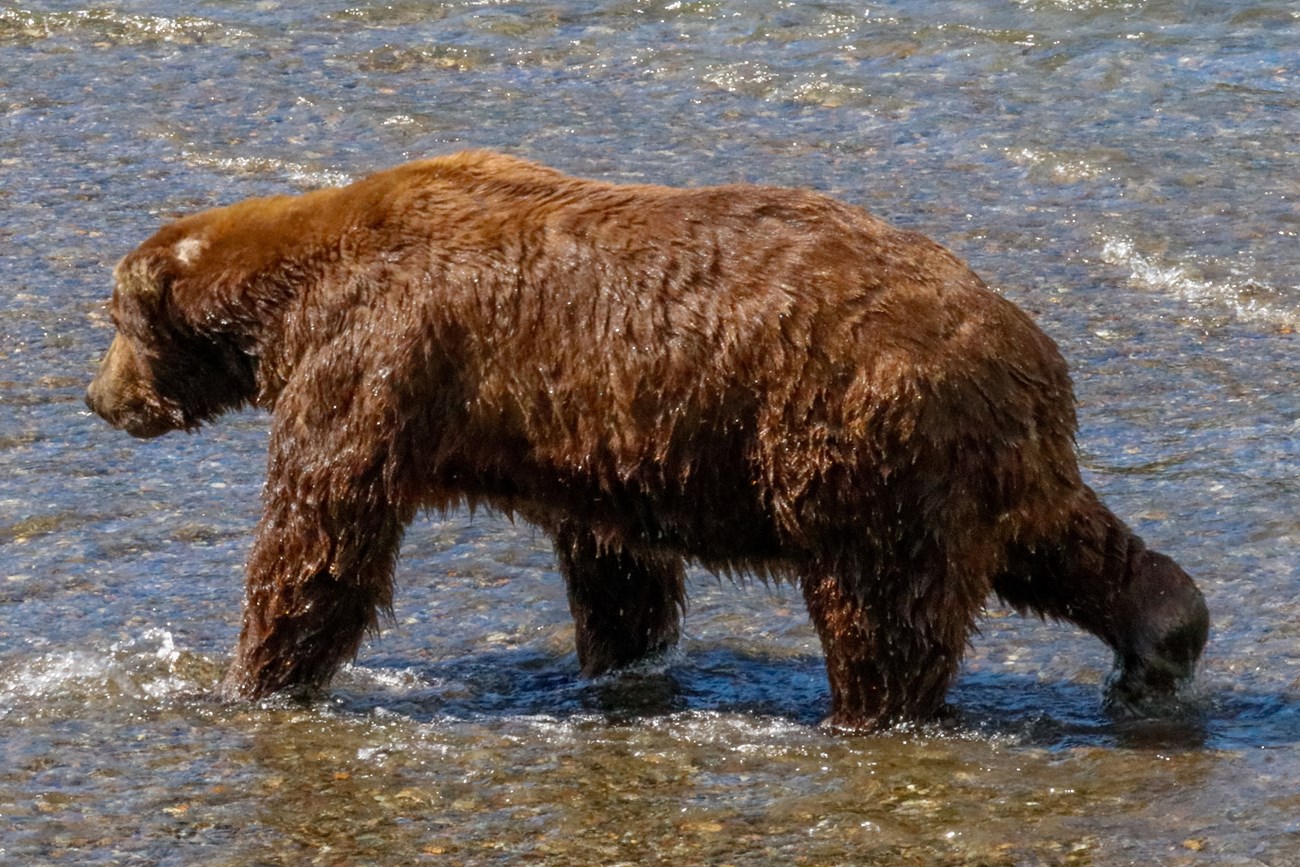
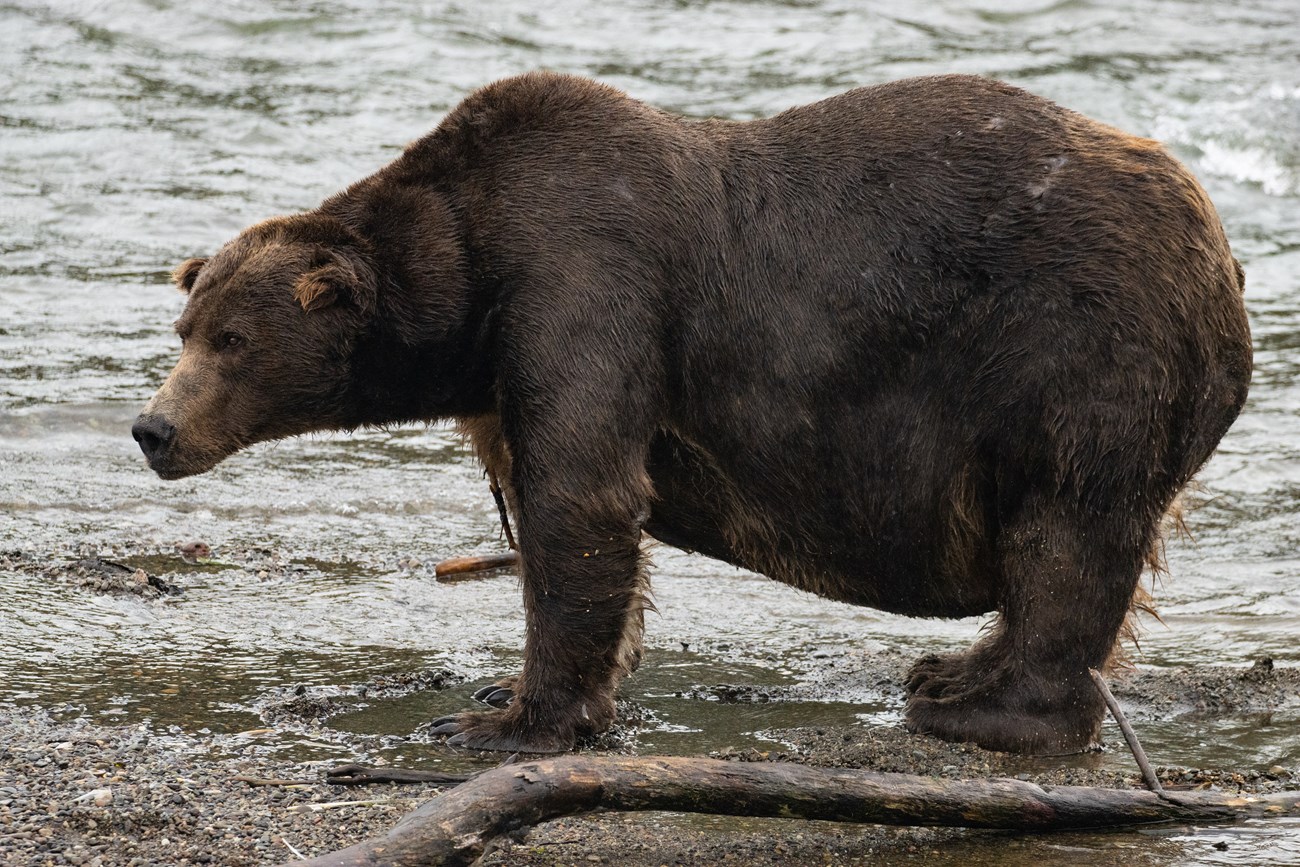
Left image
Right image
IdentificationBear 747 is a large adult male with a blocky muzzle and floppy ears. In early summer, his reddish-brown fur sheds in a patchy manner. Like many adult males, he often has scars and wounds on his face and neck. In late summer and fall, he is typically very fat with a low-hanging belly and uniformly dark brown fur.BiographyFew brown bears ever grow as large as the bear who shares an identification number with a jet airplane. When 747 was first identified in 2004, he was a relatively young bear, only a few years old and unable to compete with larger bears for the most preferred fishing locations. Since then, he has become a giant among bears, once estimated to weigh 1,400 pounds (636 kg). He is a skilled and efficient angler who is found fishing most often in the jacuzzi or near the far pool of Brooks Falls.Being big doesn’t mean you don’t face challenges, and 747 faced consistent challenges from other large males like 856 and 32 Chunk this year. In contrast to last summer, 747 deferred to both rivals in 2023 even though all three males appeared evenly matched in size. Does this signal that 747 is feeling the effects of age (he’s more than 20 years old) or might he have determined that challenging Chunk and 856 was not worth the effort when he still had access to many productive fishing spots? With his fishing skill and rank near the top of the hierarchy, advantage comes to 747 in ways that not all bears experience, but that does not mean life near the top of the hierarchy is not without its difficulties. He was the Fat Bear Week Champion in 2020 and 2022. 901 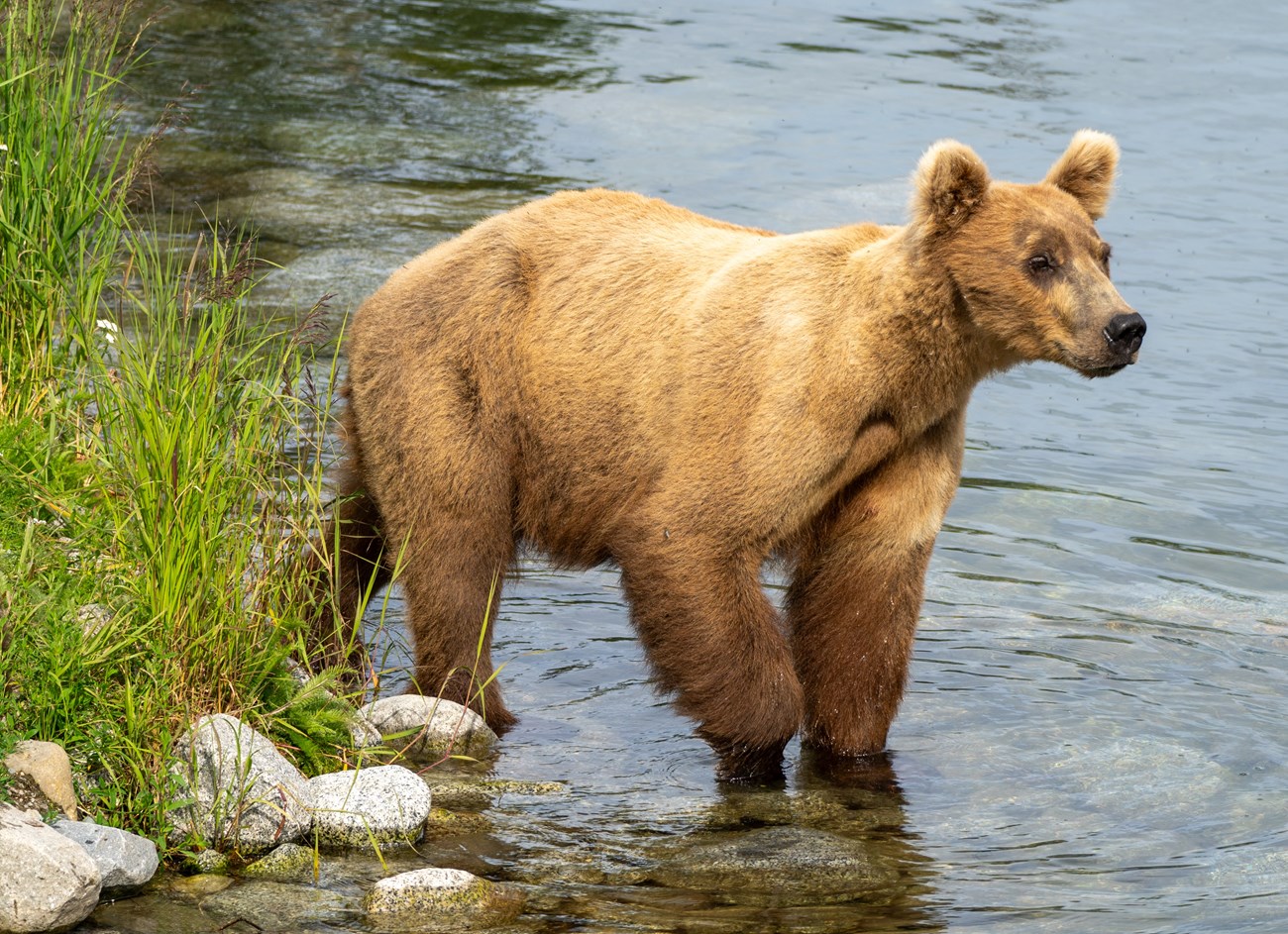
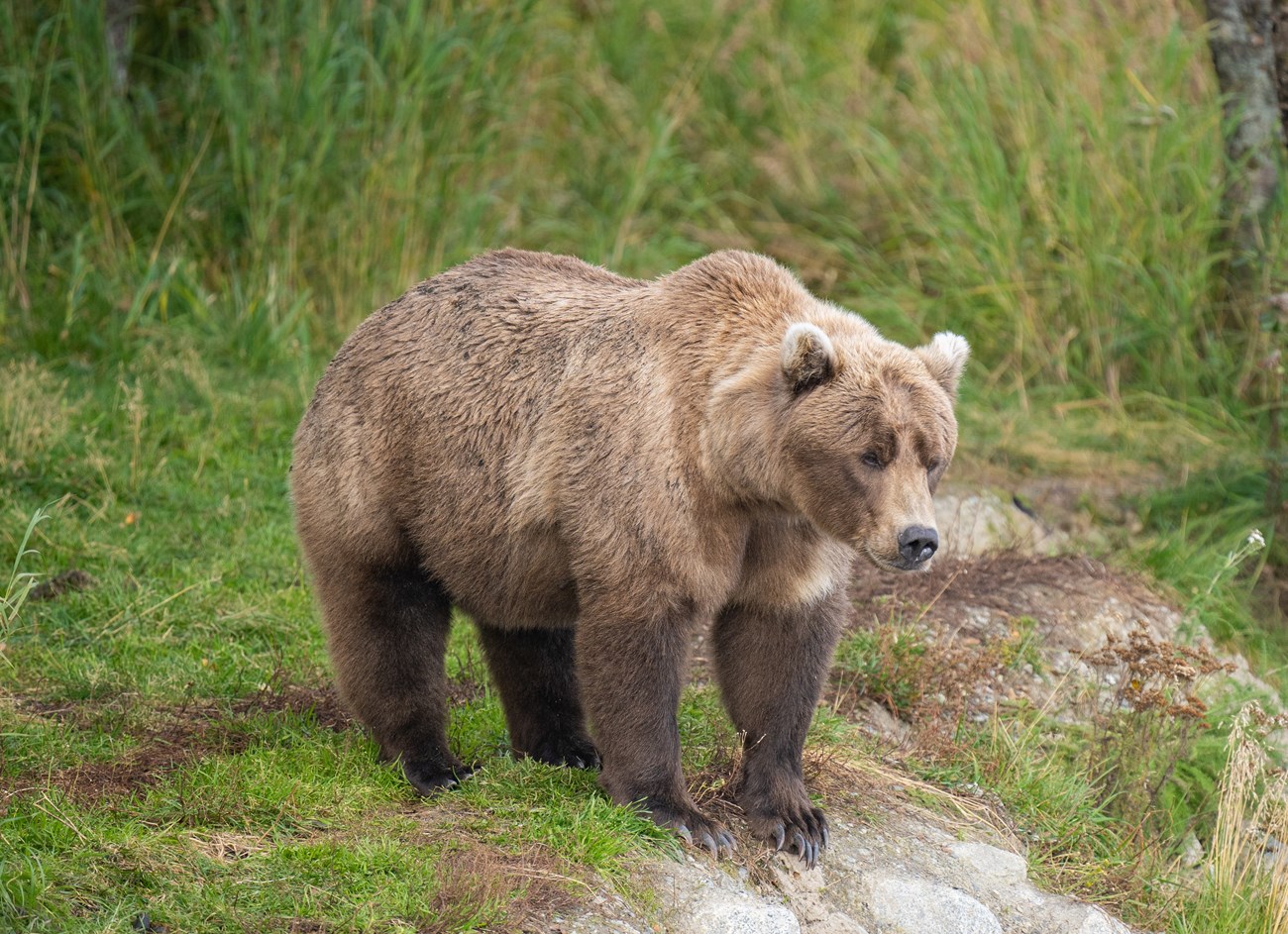
Left image
Right image
IdentificationThis is a medium-sized adult female. Bear 901 has blond-rimmed, triangular ears. Her fur is golden brown in early summer and grizzled-brown in late summer.BiographyBear 901 was first identified as a 2.5-year-old in 2018. At the end of Fat Bear Week 2022, with 901’s body fat providing the buoyancy that raised her to the final match, many people wondered if 901 would return to Brooks River with cubs in 2023. The answer came in early summer when she arrived with three spring cubs. Bear cubs are born in mid-winter while mom hibernates. Female bears with too little body fat at the start of hibernation are unlikely to give birth, so 901’s savings account of ample body fat last year positively influenced her reproductive success.With a family to care for, 901 expressed caution throughout much of the summer. She most often used the river mouth area where fewer bears are present instead of making frequent trips to Brooks Falls, likely to provide her cubs with more safety. In mid-September, though, one of her cubs disappeared while 901 fished in the lower Brooks River. Raising cubs is difficult for mother bears, and first-time mothers are particularly challenged to provision the family with food while keeping them safe. 806 Jr. 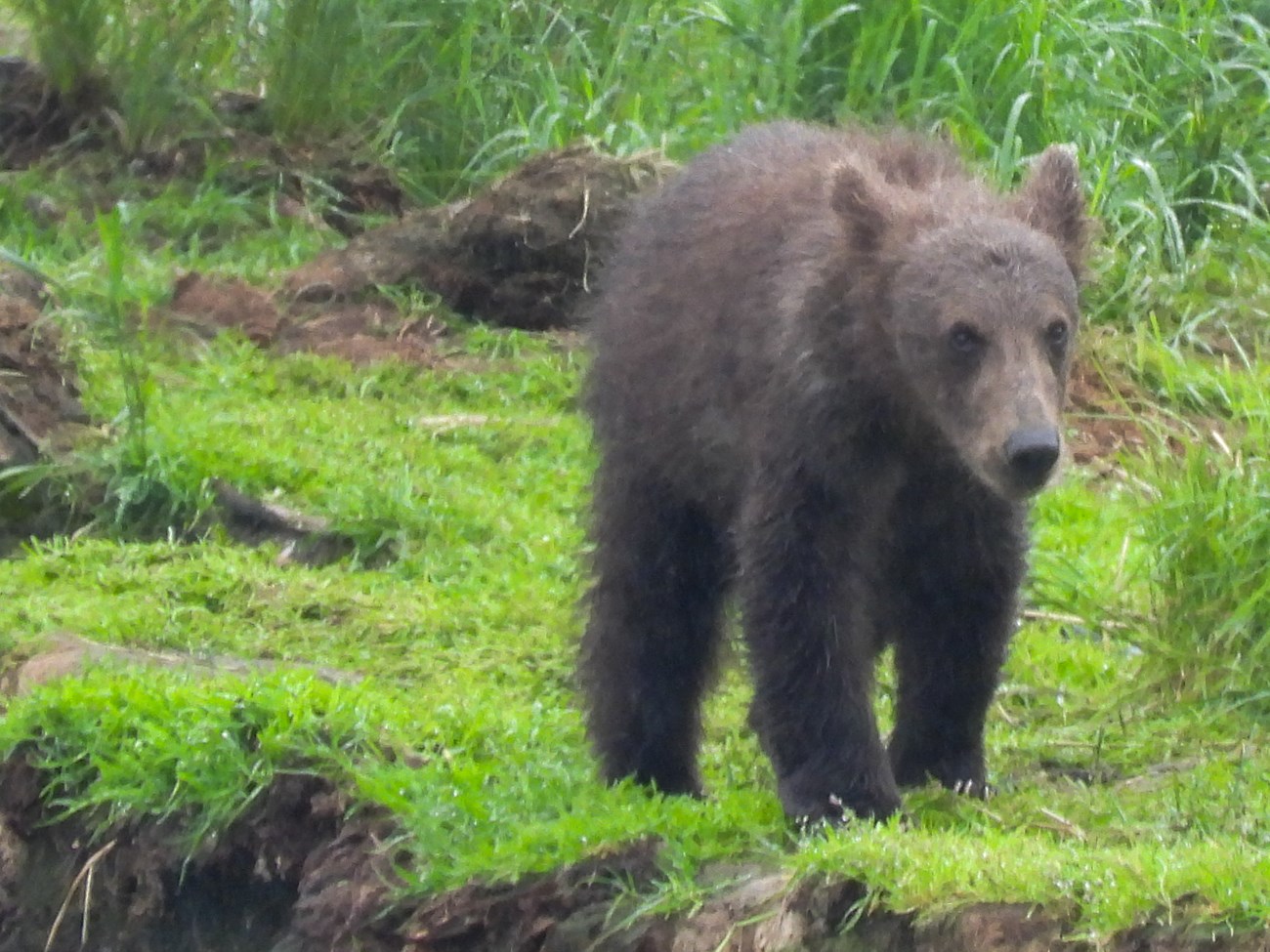
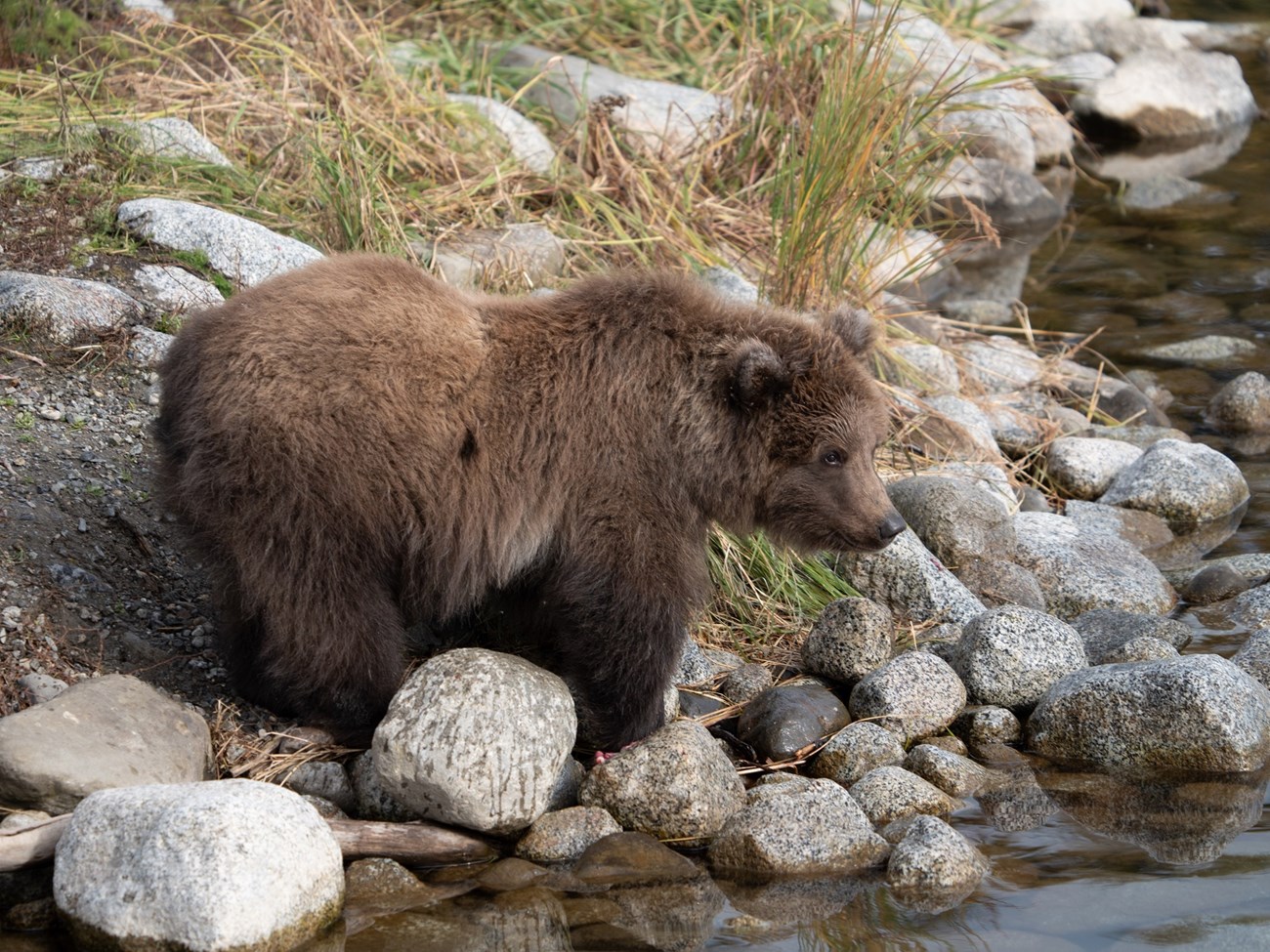
Left image
Right image
IdentificationThis male first-year cub has long, shaggy brown fur and a short, pointed muzzle.BiographyThere are perils and advantages of fishing near Brooks Falls. Many mother bears with young cubs shy away from the vicinity of the waterfall, but 806 did not avoid this area in 2023. She knew that Brooks Falls provides bears with the very first opportunities to fish for salmon in early summer. Coming so close to other bears at the falls, however, increased the risk to her cub’s safety.In his efforts to remain safe, 806’s spring cub attempted to stay close to mom even if that meant entering the swift and cold river. On several occasions, he was swept downstream or over the waterfall. In a notable event in late July, his mother fell off the falls as she caught a fish, which left the cub alone momentarily. A nearby adult male then pursued and attacked the cub. Thankfully, 806 was able to return and successfully defend her offspring. Mother and cub returned frequently to the falls afterward and throughout August. With salmon abundant in mid-summer, 806’s cub grew rapidly. His story showcases the risk and reward that bears find at Brooks Falls. He is the 2023 Fat Bear Junior Champion. |
Last updated: October 3, 2023
